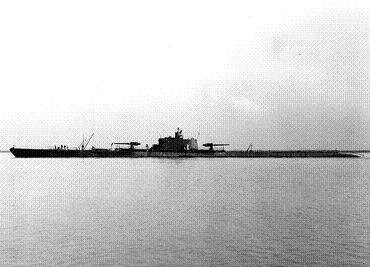![]() The Pacific War Online Encyclopedia
The Pacific War Online Encyclopedia
|
| Previous: Narayanganj | Table of Contents | Next: Nashioka Hisao |

| Tonnage |
2730 tons standard displacement 3900 tons submerged |
| Dimensions | 371' by 33'3" by 15"9" 113.08m by 10.13m by 4.80m |
| Maximum speed | 17 knots surfaced 6.5 knots submerged |
| Maximum dive |
300 feet 90 meters |
| Complement | 89 |
| Armament | 4 21" bow/2 21" stern torpedo
tubes (24 torpedoes) 2 6"/53 guns |
| Machinery |
2-shaft M.A.N. diesel-electric
(5600 bhp surfaced, 1600 shp submerged) |
| Bunkerage | 560 tons diesel oil 18,360 gallons (69,500 liter) gasoline (Nautilus) |
| Range | 9380 nautical miles (17,370 km) at 10 knots surfaced 50 nautical miles (90 km) at 5 knots submerged |
| Sensors |
JK
sonar QCD sonar |
| Cargo | 115 tons |
| Modifications |
Two bow and two stern exterior torpedo tubes added to Nautilus in early 1942 during her refit. Narwhal did not receive the extra tubes until early 1943. |
The Narwhals were
completed in 1930 as part of the V program, and were originally designated V-5 and V-6. They were the
culmination of the cruiser sub concept in the U.S. Closely resembling Argonaut but with a heavier torpedo armament in place of mine laying capability, they were big and roomy, which
made them natural
candidates for transport missions such as the raid on Makin. They also incorporated a number of innovative safety and rescue features prompted by the losses of S-51 and S-4.
However, they could rarely maintain
the design speed of 17 knots, and they were clumsy, slow-diving boats
that were easily detected surfaced or submerged. Subsequent submarine
designs would be
considerably smaller than the Narwhals.
Both ships spent most of the war on transport missions, which in addition to the Makin raid included landing a reconnaissance force at Attu. Nautilus was assigned to island reconnaissance duty in 1943, and spent 18 days taking 2000 pictures of potential landing areas at Tarawa.
|
Under refit at San Francisco |
References
The Pacific War Online Encyclopedia © 2007, 2009, 2013 by Kent G. Budge. Index